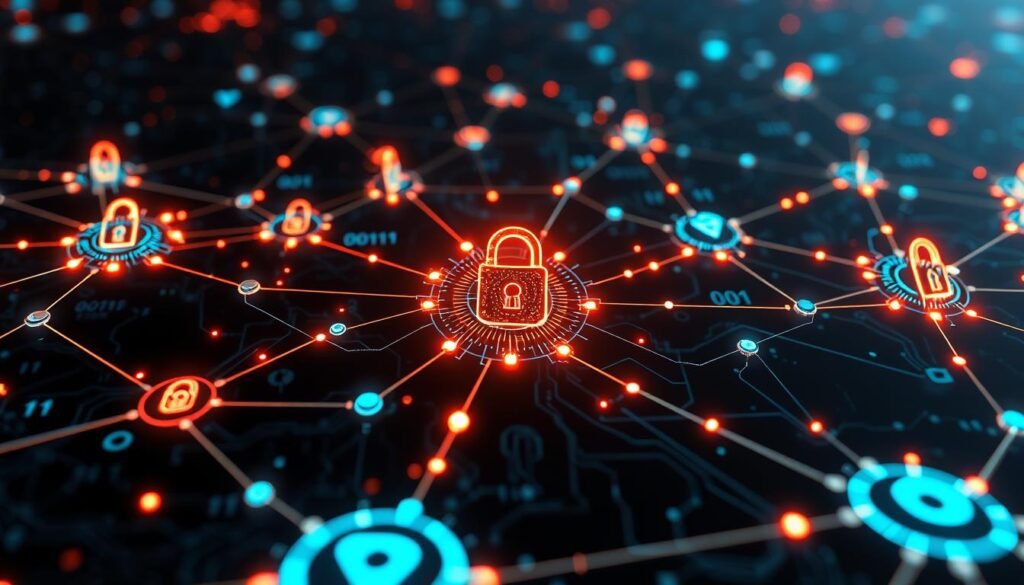In today’s digital world, cyber threats are everywhere. Your network security policies are key to protecting your data and following the law. But what makes a good network security policy? Can a well-made policy really improve your cybersecurity?
This article will show you how to make strong network security policies. We’ll cover the main parts, how to put them into action, and the best ways to do it. You’ll learn how to make your network safe and keep your data secure.

Key Takeaways
- Understand the fundamental elements of effective network security policies
- Explore the core components and implementation framework for security policies
- Discover best practices for firewall configuration and data encryption protocols
- Learn about access control, authentication, and employee security awareness training
- Implement robust incident response and vulnerability management strategies
Understanding Network Security Policy Fundamentals
Creating a strong network security policy is key to protecting your digital assets. It starts with knowing the basic rules that guide these policies. This includes setting up network access control and using top-notch intrusion detection and prevention systems. Security policies are essential for keeping your network safe.
Core Components of Security Policies
Good network security policies have a few main parts. They include:
- Clear rules for who can connect and what devices can be used
- Systems to quickly spot and stop threats
- Regular checks to see if security measures are working
Policy Implementation Framework
To put a security policy into action, you need a clear plan. This plan should make sure everything works together smoothly. It usually involves:
- Setting up who is in charge of following the policy
- Ways to share policy updates with everyone
- Tools to watch and report on how well the policy is followed
Regulatory Compliance Requirements
Your network security policy must also meet certain rules, like HIPAA, PCI-DSS, or GDPR. Following these rules is important to avoid fines and damage to your reputation.
Knowing the basics, how to implement them, and the rules you must follow helps you make a solid network security policy. This policy will protect your important data and systems.
Essential Elements of Firewall Configuration
Firewalls are key to network security. They control what traffic can enter or leave a network. Knowing about types of network firewalls like packet filtering, stateful inspection, and application-level gateway firewalls is vital.
A packet filtering firewall checks each packet’s header. It decides to block or allow traffic based on rules. This ensures only approved communications pass through.
A stateful inspection firewall keeps track of network connections. It knows about active sessions. This helps it decide whether to let a packet through or not.
An application-level gateway firewall looks at the data in packets. It checks specific protocols like HTTP or FTP. This adds extra security to the network.
Setting up these firewalls needs a good grasp of network protocols and security. By making smart firewall rules, experts can protect against many threats.
“The key to effective firewall configuration is to strike a balance between security and accessibility, ensuring that legitimate users and applications can operate seamlessly while unauthorized access is prevented.”
In short, learning about firewall setup is essential for strong network security. Using the right types of network firewalls helps protect digital assets.
Network Security Policy Best Practices
Creating a strong network security policy is key to protecting your digital assets. To make your policy effective and practical, follow these best practices:
Documentation Standards
Set clear standards for your network security policy. Define its purpose, scope, roles, and responsibilities. Also, outline the security controls and procedures. Well-documented policies make implementation easier and help with regular updates.
Policy Review Cycles
- Have a regular review cycle for your policy, like every year or every two years.
- This cycle should check if the policy works well, update it for new tech, laws, or business needs, and make any needed changes.
- Get input from IT, security experts, and business leaders. This ensures the policy fits your goals and follows industry standards.
Enforcement Strategies
Effective enforcement is key to your policy’s success. Make sure everyone knows the rules and what happens if they don’t follow them. Also, teach all employees about their role in keeping security high.
Use strong incident response planning and patch management to handle security issues fast. A proactive approach to enforcement boosts your organization’s security.
“A well-designed and effectively implemented network security policy is the foundation of a secure digital environment.”
Implementing Data Encryption Protocols
In today’s digital world, protecting sensitive information is key. Using strong data encryption protocols is vital for your network’s safety. Whether you use cloud, hardware, or software solutions, good encryption is essential. It can mean the difference between keeping your data safe and facing a breach.
The Advanced Encryption Standard (AES) is becoming more popular. It comes in 128-bit, 192-bit, and 256-bit versions. AES is great for keeping data safe in many settings, like cloud and hardware firewalls.
Transport Layer Security (TLS) is also important. It’s often paired with HTTPS to keep web communications safe. Using TLS helps protect data as it moves between your network and others, adding a layer of security.
| Encryption Protocol | Key Length | Applications |
|---|---|---|
| AES | 128-bit, 192-bit, 256-bit | Cloud Firewalls, Hardware Firewalls, Software Firewalls |
| TLS | N/A | Securing Web-based Communications |
Using these encryption protocols can keep your network’s sensitive info safe. It doesn’t matter if you’re using cloud, hardware, or software firewalls. Strong encryption is a must for network security.

“Encryption is not a binary choice, but a continuous journey of improvement and adaptation to the ever-evolving threat landscape.”
Access Control and Authentication Methods
Keeping your network safe is key. This means having strong access control and authentication. We’ll look at role-based access control, multi-factor authentication, and privileged access management. These methods help protect against unauthorized access and data breaches.
Role-based Access Control
Role-based access control (RBAC) gives access based on a person’s role in the company. It makes managing users easier and reduces the chance of unauthorized actions. It’s great when used with advanced firewalls like unified threat management firewalls and next-generation firewalls.
Multi-factor Authentication
Multi-factor authentication (MFA) asks for more than one thing to get into a system. It might ask for a password and a code sent to your phone. This makes it harder for hackers to get in, even if they have your password. Using MFA with circuit-level gateway firewalls adds extra security.
Privileged Access Management
Privileged access management (PAM) controls users with special access, like IT staff. It limits what they can do and watches their actions. This makes it harder for hackers to get to important stuff. Using PAM with strong firewalls like unified threat management firewalls helps keep systems safe.
Using these methods together makes your network security stronger. It helps protect your important data from hackers and unauthorized access.
Employee Security Awareness Training Programs
Keeping your network safe is more than just using technology. It’s also about teaching your employees about employee security awareness training. This training is key to protecting your company from cyber threats.
It’s important to teach your team about proxy firewalls and application-level gateways. These tools help block bad access, fight malware, and keep your network safe. By learning about these tools, your employees will better understand how to keep your network secure.
- Teach employees to spot and report suspicious activities, like phishing or unauthorized access.
- Guide them on how to use proxy firewalls and application-level gateways safely.
- Stress the need for strong passwords, multi-factor authentication, and other security practices.
- Keep training up to date with new threats and best practices.
By investing in employee security awareness training, you make your team a strong defense against cyber threats. This approach helps protect your data and keeps your network safe for the long term.

| Training Topic | Key Objectives |
|---|---|
| Cybersecurity Fundamentals | Educate employees on common cyber threats, such as phishing, malware, and unauthorized access attempts. |
| Proxy Firewalls and Application-level Gateways | Explain the role and importance of these security technologies in protecting the network. |
| Access Control and Authentication | Promote best practices for password management, multi-factor authentication, and privileged access management. |
| Incident Response and Reporting | Ensure employees understand how to identify and report suspicious activities or security incidents. |
“Educating employees on network security is key to a strong defense. It’s not just about tech, but about making people security-aware in their daily work.”
Incident Response and Recovery Planning
Securing your network is key. A solid incident response and recovery plan is essential. It outlines how to detect, address, and recover from security incidents. This ensures your organization can quickly and effectively handle threats like packet filtering firewalls, stateful inspection firewalls, and cloud firewalls.
Incident Detection Procedures
Effective incident response starts with reliable breach detection. This involves monitoring network traffic, analyzing log files, and using intrusion detection and prevention systems. Quick detection of suspicious activity allows for swift response and less damage.
Response Team Responsibilities
- Establish a dedicated incident response team with clear roles and responsibilities.
- Ensure team members have the necessary skills and resources to manage security incidents effectively.
- Develop communication protocols to inform stakeholders and coordinate the response effort.
Recovery Protocol Implementation
After a security breach, your recovery plan should detail how to restore operations. This includes steps to recover lost data and address vulnerabilities. Procedures might include restoring from backups, applying security patches, and forensic analysis to find the breach’s cause.
| Firewall Type | Role in Incident Response |
|---|---|
| Packet Filtering Firewalls | Provide basic network access control by examining the headers of incoming and outgoing packets to enforce access policies. |
| Stateful Inspection Firewalls | Monitor the state of network connections, allowing for more advanced security policies and better detection of anomalies. |
| Cloud Firewalls | Offer scalable, cloud-based firewall solutions that can adapt to changing network conditions and provide centralized management and visibility. |
With a thorough incident response and recovery plan, your organization is ready to face security incidents. This minimizes their impact on your operations and safeguards your data and resources.
Vulnerability Management and Assessment
Keeping your network safe needs a proactive plan for managing and checking vulnerabilities. Using unified threat management (UTM) firewalls and setting up firewalls right is key. Also, making sure remote access is secure is very important.
It’s important to do regular security checks and updates. This helps find and fix vulnerabilities in your network. UTM firewalls can handle many security tasks like stopping intrusions and filtering content in one place. Making sure these firewalls are set up correctly is essential to keep them working well and blocking threats.
Also, it’s critical to protect remote access to your network. This is because hackers often try to get in through remote access. Using strong login methods and secure connection protocols can help keep your network safe. This reduces the chance of data breaches.



